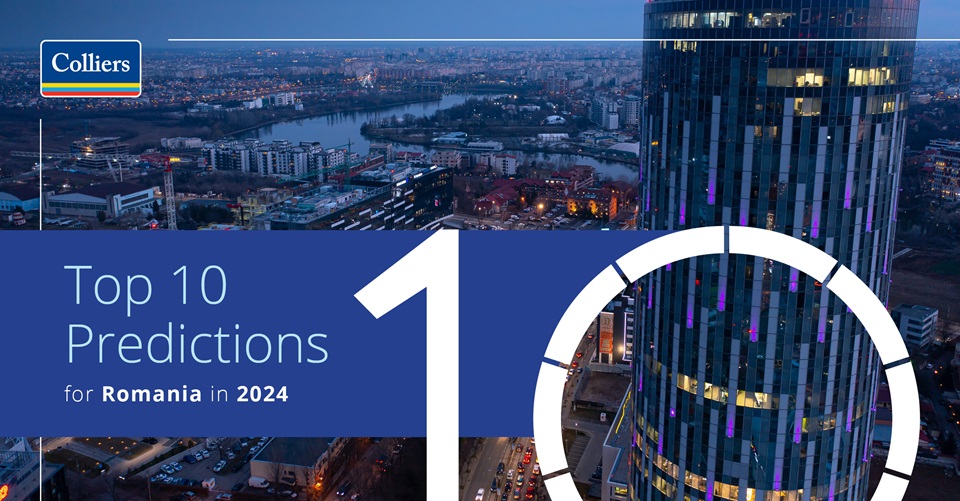Colliers: 2024 looks quite optimistic for Romania’s real estate market

Romania’s real estate market remains a sector with high growth potential, even if the pace could be slower in 2024 than before the pandemic, Colliers consultants predict in ”Top 10 Predictions Romania 2024” report.
However, this year is likely to be better than 2023 for a multitude of subsectors. For instance, there are favorable underlying trends in industrial operations, partly due to the friend-shoring movement, availability and cost of the labor force, and recent or expected improvements with regards to infrastructure.
2024 is also expected to remain difficult for the local investment market with the prospect of better days ahead due to lower interest rates, a growing shift in focus from retail parks to large retail projects, and an increase in both demand and affordability in the residential market. Colliers consultants point out that this year will also be dominated by a lot of political noise, given the presidential, general, local and EU Parliament elections.
2024 looks quite optimistic for Romania’s economy and, by extension, the real estate market. Some of the most encouraging signs are the ongoing major infrastructure developments, the substantial capital inflows expected through European funds or the fact that Romania becomes a more prominent regional distribution hub, especially for South-Eastern Europe. In addition, the still tight labor market, a better external context for Romania’s main trading partners, plus a pullback in inflation, suggest that 2024 should turn out better than 2023, the Colliers consultants point out, who also underline that Romania’s economic growth is estimated in the area of 3% this year. Still, there are also concerns both internally, such as the country’s huge fiscal imbalance, and externally, where some major uncertainties, particularly regarding geopolitics, persist.
2023 was a decent year for infrastructure developments in Romania, with 80 kilometers of highways and express roads put into service, well above the annual average of the last 33 years (26.6 km). And the major infrastructure transformation continues in 2024 and beyond. The country’s c. 1,000 km network of high-speed roads could double in size, as around 800 kilometers are currently being worked on, with works set to start sooner or later on other sections. Major modernization improvements are also planned for railways in some parts of the country. The prospect of an improved business environment, coupled with a potential entry into the Schengen area for terrestrial borders, attracts investors’ attention, particularly for areas of the country with lower wages and better labor availability, according to Colliers consultants, leading to a better distribution of growth and economic resources.
Romania’s geographical position, as well as its specific economic advantages – in particular the elevated gap between labor costs and labor productivity, comparable to China, for example -, supports the idea that Romania will become a hotspot for logistics and manufacturing activities in the context of the “friend-shoring” trend. External reports are also taking stock of such trends, as the CEE is set to become the center of gravity for European growth, according to the National Institute of Economic and Social Research. While companies cannot ignore Asia or parts of South America for production, they can diversify their operations better to mitigate risks and the CEE, including Romania, is well placed to see much more investments in the coming years – a trend that Colliers consultants have started to notice as of the last couple of years, even in Romania.
Politics will be in the spotlight this year, when Romanians are expected to vote four times. For the first time in the country’s recent history, the president, mayors and parliamentarians finish their mandate in the same year. This means there will be local, presidential, parliamentary and European elections. The main scenario that local political experts are currently pushing for is a continuation of the current governing coalition post-elections, a pro-EU/pro-Western socialist-liberal coalition, but there is still room for surprises. On the other hand, the lack of elections starting 2025 creates a more favorable context for less popular, but necessary reforms.
The office market is expected to see the lowest deliveries in around two decades. Only one major project of around 16,000 square meters could be delivered this year in Bucharest, for example, making this the weakest year since 2004-2005, when the office market was in its incipient phase, Colliers consultants note. Regional cities are also set to not see any major deliveries as well. Meanwhile, demand remains moderate, with the vacancy absorption rate at the level of last cycle’s average. That said, well-located and ESG-compliant properties are in much higher demand, which is already shifting parts of the market towards a landlord’s market, in certain submarkets/areas in Bucharest, for example, and may also lead to higher rents after last year’s c.10% increase in rents.
Industrial and logistics sector remains active, especially compared to pre-pandemic levels, although the unprecedented increase in rents, of over 10% per year in both 2022 and 2023, affects the attractiveness of Romanian warehouse facilities for international companies. The outlook remains promising, as Romania ended 2023 with less than 7 million square meters of modern warehousing, a rather limited supply on a European standard, particularly given the ongoing infrastructure improvements and the expected increased demand amid re-shoring.
Following a few years when retail parks were the star of the retail market, Colliers’ consultants are seeing a growing interest in large projects, both stand-alone and integrated into major mixed-use developments, and expect that in 2024 a multitude of such schemes across the country will continue or start development. Meanwhile, on the consumers’ side the drop in inflation and hefty wage growth should continue to fuel the spending appetite and retail sales may actually accelerate relative to 2023. After the inflation boom of the last few years, Colliers’ consultants anticipate that discounters are once again at the top preferences.
Colliers’ consultants anticipate an increase in both demand and affordability for the residential market. Lots of Romania’s dynamic cities and economic areas are facing overcrowding, sustaining in the long run the demand for affordable residential units in many parts of the country. In addition, the anticipated easing of the central bank’s monetary policy, expected to begin by mid-2024, together with robust wage growth, should support buying interest. For the most part, price affordability relative to wages has deteriorated slightly in recent years, but from 2023 this trend has reversed and we expect this favorable dynamic for consumers to continue.
In the land market, Colliers’ consultants noted a slight decline in investor appetite in 2023, as measured by new inquiries, and this trend is likely to continue in 2024 as many developers already have land for future development. However, a number of large deals that have been in the pipeline for some time could be completed in 2024, resulting in a solid year. Good land plots continue to command a premium over the rest, and if longer-term uncertainties dissipate reasonably, land prices may start increasing again more substantially.
Things could start to look up for the local investment market as ECB and Fed interest rates are expected to start falling by mid-2024, albeit at a much slower pace than they have been rising. This means that the second half of the year could look better. There are some bigger tickets in the works at the start of the year, but after some deals fell through in 2023, it is difficult to have any certainty. Volume-wise, we could see 2024 as quite similar to last year’s half a billion euros.














